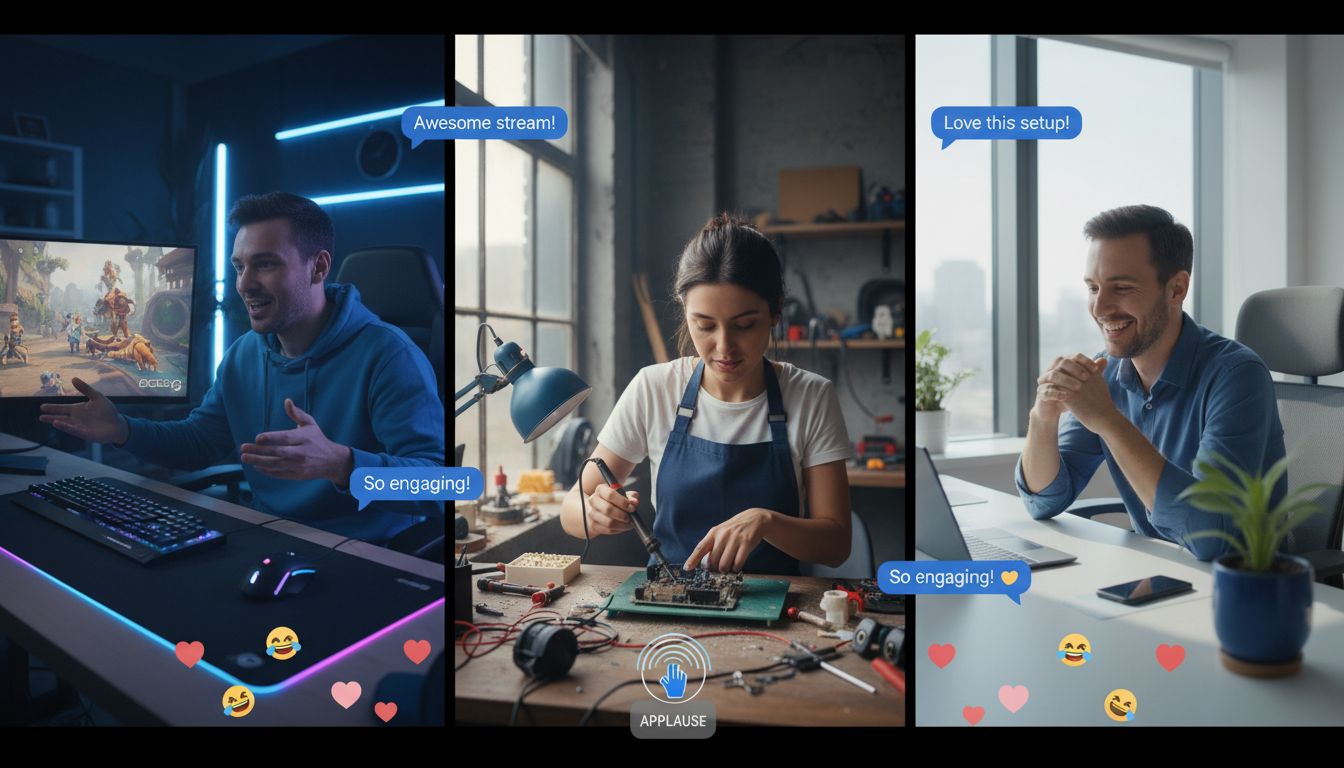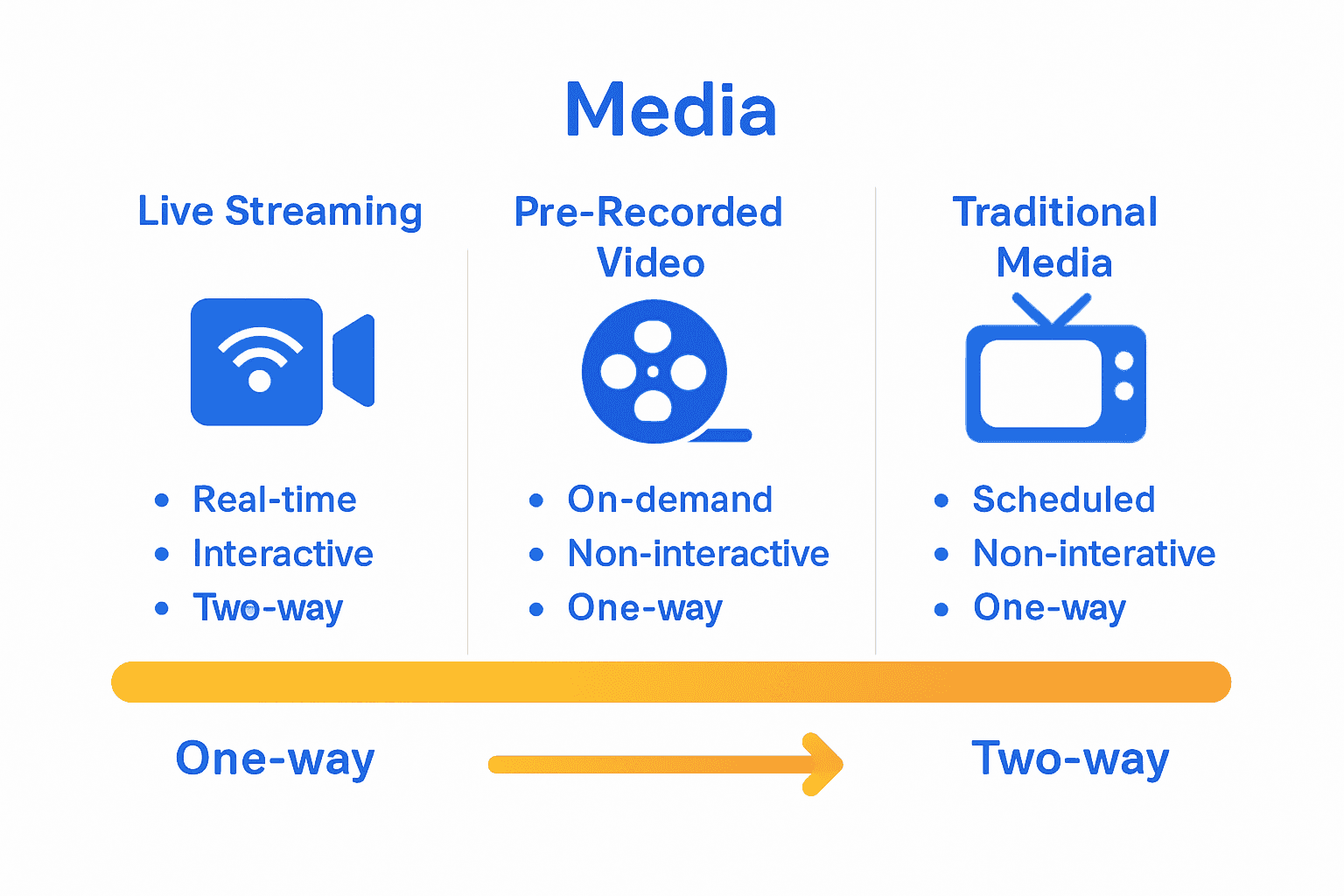目次
More than one in four internet users now watch live streams regularly, showing just how quickly this form of engagement is spreading. Live streaming has shifted digital interactions from scripted moments to spontaneous, real connections between creators and their audiences. From real-time expertise sharing to interactive entertainment, understanding the core ideas behind live streaming helps both creators and viewers make the most out of every broadcast.
目次
- Defining Live Streaming Content And Core Concepts
- Types Of Live Streaming: Solo, Interactive, Group
- How Live Streaming Platforms Operate
- Essential Equipment And Creator Requirements
- Legal, Safety, And Monetization Considerations
- Comparing Live Streaming To Other Content Models
要点
| Point | Details |
|---|---|
| Live Streaming Characteristics | Live streaming offers real-time engagement, direct communication, and unedited content delivery, setting it apart from traditional media. |
| Types of Live Streaming | The three main types—solo, interactive, and group streams—each foster different levels of audience interaction and cater to various content needs. |
| Technical Requirements | Successful live streaming necessitates quality equipment, reliable internet, and crucial skills for audience engagement and technical troubleshooting. |
| Legal and Monetization Aspects | Creators must navigate legal considerations while exploring diverse monetization strategies to ensure sustainable and compliant content production. |
Defining Live Streaming Content and Core Concepts
Live streaming represents a dynamic digital communication method that enables real-time video and audio broadcasting over the internet. Live streaming content allows creators to share experiences, skills, and interactions directly with audiences across digital platforms. According to Internet Matters, live streaming involves the immediate transmission of video and audio content, creating an interactive experience between broadcasters and viewers.
At its core, live streaming enables instantaneous digital communication where content is transmitted and consumed simultaneously. Unlike pre-recorded videos, live streams generate immediate engagement, allowing real-time interactions, comments, and reactions. ALA Research highlights that live streaming is particularly powerful for educational and skill demonstration purposes, enabling instructors and creators to connect authentically with their audiences.
The key characteristics of live streaming content include:
- Real-time video and audio transmission
- Immediate audience interaction
- Direct communication between creator and viewers
- Unedited, spontaneous content delivery
- Platform-based broadcasting capabilities
Creators across various domains leverage live streaming for different objectives. From educational tutorials and skill demonstrations to entertainment and personal branding, live streaming has transformed how digital content is produced and consumed. Role of Live Streaming: Complete Guide for Creators provides deeper insights into the strategic implementation of live streaming for modern digital creators.
Types of Live Streaming: Solo, Interactive, Group
Live streaming encompasses diverse content formats, each offering unique engagement opportunities for creators and audiences. According to NASBA Registry, live streaming can be strategically categorized into three primary types: solo streams, interactive streamsそして group streams. Each format serves distinct communication objectives and audience interaction levels.
Here’s a comparison of the three main types of live streaming:
| Streaming Type | Primary Features | Audience Interaction Level | Common Uses |
|---|---|---|---|
| Solo Streams | Single creator Personal style Consistent delivery |
中程度 | Tutorials Vlogging Personal branding |
| Interactive Streams | Real-time engagement Audience participation Live reactions |
高い | Q&A sessions Gaming Fan chats |
| Group Streams | Multiple creators Collaboration Diverse perspectives |
Very High | Panel discussions Collaborative events |
Solo Streaming represents the most straightforward live streaming approach, where a single creator broadcasts content directly to their audience. In these streams, the creator maintains complete control of the narrative, sharing personal experiences, skills, tutorials, or entertainment content. Creators leverage solo streams to build personal connections, demonstrate expertise, and maintain a consistent content delivery style.
Key streaming types include:
- Solo Streams: Single creator broadcasting
- Interactive Streams: Real-time audience engagement
- Group Streams: Multiple participants collaborating
Harvard Business School highlights that interactive streams represent a dynamic content format where audience participation becomes central to the broadcasting experience. These streams enable real-time comments, questions, polls, and direct communication between creators and viewers. 7 Top Fan Engagement Techniques for Creators and Users provides additional strategies for maximizing audience interaction during live streams.
Group Streaming introduces a collaborative dimension, allowing multiple creators or participants to broadcast simultaneously. This format is particularly powerful for panel discussions, collaborative performances, multi-perspective content, and shared experiences. Group streams create complex, enriched viewing experiences that go beyond traditional single-creator broadcasts, offering audiences diverse perspectives and interactive engagement opportunities.

How Live Streaming Platforms Operate
Live streaming platforms represent complex technological ecosystems designed to facilitate real-time digital content transmission. According to University Research, these platforms function by encoding video and audio content, packaging it for delivery, and transmitting it seamlessly over the internet to reach viewers in real-time.
The technical infrastructure of live streaming platforms involves several critical components:
- ビデオキャプチャー: Converting physical camera input into digital signals
- エンコーディング: Compressing video data for efficient transmission
- Content Packaging: Preparing streams for different devices and network conditions
- Distribution: Routing content through content delivery networks
- Playback: Enabling viewers to receive and watch streams
Graduate School Research highlights that these platforms provide creators with sophisticated tools to interact with their audience and manage broadcasts effectively. The technological backbone enables real-time communication, allowing instant feedback, comments, and engagement between streamers and viewers.
Modern streaming platforms have evolved to offer comprehensive features beyond basic transmission. Best Creator Platforms Like Fanvue explores how advanced platforms integrate monetization tools, audience analytics, and interactive features that transform simple broadcasting into sophisticated digital experiences. These platforms now serve as complex ecosystems that support creators’ entire digital content strategy, providing robust infrastructure for professional and personal broadcasting needs.
Essential Equipment and Creator Requirements
Successful live streaming demands a strategic combination of technical equipment and personal skills. Discovery Trust emphasizes that effective live streaming requires several critical components: a reliable internet connection, high-quality camera, professional microphone, and appropriate lighting setup. These foundational elements transform amateur broadcasts into professional-grade content experiences.
Essential Equipment Checklist:
- Camera: HD or 4K resolution
- Microphone: Professional-grade audio capture
- Lighting: Consistent, flattering illumination
- Internet Connection: Stable, high-speed broadband
- Streaming Software: Robust broadcasting platform
Kent University research highlights that beyond physical equipment, creators must develop crucial skills in content creation, audience engagement, and technical troubleshooting. These soft skills complement technical capabilities, enabling streamers to create compelling, interactive experiences that retain viewer interest.
Beyond hardware, creators must invest in continuous learning and platform-specific knowledge. Paid Content Sharing Tools Comparison suggests that understanding platform-specific features, monetization strategies, and audience interaction techniques can significantly enhance a creator’s streaming performance. Successful streaming is not just about equipment, but about creating genuine connections and delivering high-quality, engaging content that resonates with your audience.
Legal, Safety, and Monetization Considerations
Live streaming involves complex legal and safety challenges that creators must carefully navigate. Internet Matters highlights critical concerns including privacy risks, potential exposure to inappropriate content, and the importance of implementing robust safety measures to protect both creators and their audience.
Key Safety and Legal Considerations:
- Personal Privacy Protection
- Age and Identity Verification
- Content Compliance
- Platform-Specific Guidelines
- Intellectual Property Rights
NASBA Registry emphasizes that monetization strategies must align with legal requirements and platform policies. Successful creators explore diverse revenue models including subscriptions, direct fan support, sponsorships, and platform-specific monetization tools. Understanding these frameworks is crucial for sustainable content creation.
Why Monetize Content: Complete Guide for Creators provides insight into developing comprehensive monetization strategies. Creators must balance audience engagement, legal compliance, and financial sustainability. This requires continuous learning, adapting to platform changes, and maintaining transparent relationships with viewers while protecting their personal and professional boundaries.
Comparing Live Streaming to Other Content Models
ライブ・ストリーミング fundamentally transforms digital content consumption by offering an unprecedented level of real-time interaction. ALA Research highlights that live streaming differs critically from traditional content models by providing immediate feedback and creating a sense of community that static media cannot replicate.
Key Comparative Characteristics:
- Pre-Recorded Content: Edited, polished, static
- ライブ・ストリーミング: Spontaneous, interactive, authentic
- Traditional Media: One-way communication
- ライブ・ストリーミング: Bidirectional engagement
- Recorded Videos: Permanent, unchangeable
Internet Matters emphasizes that live streaming provides a more authentic connection between creators and audiences compared to pre-recorded content. This dynamic format allows for spontaneous interaction, real-time reactions, and an immersive experience that traditional media models cannot match.
Why Switch from OnlyFans? explores how emerging platforms are revolutionizing content models. Unlike traditional monetization strategies, live streaming enables creators to build deeper, more immediate connections with their audience, transforming content consumption from a passive experience into an interactive, engaging journey.

Elevate Your Live Streaming Experience with Fanspicy
Live streaming can feel overwhelming when trying to balance high-quality equipment, real-time audience engagement, and effective monetization. This article highlights common challenges such as maintaining consistent interaction, managing streaming tools, and protecting your privacy while building authentic connections. If you want a streamlined solution that supports solo, interactive, and group streams with built-in monetization and safety features, it is time to explore a platform designed specifically for creators like you.

Discover how ファンスパイシー can transform your live streaming efforts into a powerful income source with easy setup and audience tools made for genuine engagement. Why wait to create professional, interactive content? Visit Fanspicy now to experience a modern paid social media platform that goes beyond traditional options. Take control of your live streams, connect with your fans directly, and start monetizing your passion today.
よくある質問
What is live streaming content?
Live streaming content is a dynamic way of transmitting video and audio content over the internet in real-time, allowing creators to interact with their audience instantly.
What are the different types of live streaming?
The three main types of live streaming are solo streams, interactive streams, and group streams, each offering different levels of audience engagement and communication objectives.
What equipment do I need for successful live streaming?
To effectively live stream, you’ll need essential equipment including a high-quality camera, professional microphone, proper lighting, a stable internet connection, and suitable streaming software.
クリエイターはライブストリームをどのように収益化できるのか?
Creators can monetize their live streams through various strategies such as subscriptions, direct fan support, sponsorships, and utilizing platform-specific monetization tools.
